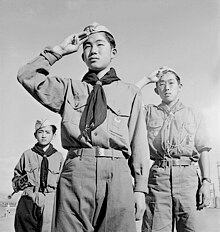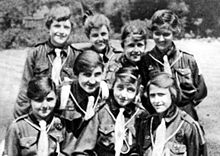This article has multiple issues. Please help improve it or discuss these issues on the talk page. (Learn how and when to remove these messages)
|
| Scout method | |||
|---|---|---|---|
 World War II era Japanese American Boy Scouts, Heart Mountain Relocation Center, Heart Mountain, Wyoming | |||
 Girl Guides in the United Kingdom, 1918 | |||
|
| |||
The Scout method is the informal educational system used in the Scouting Movement.[1] The aim of Scouting is character training with the goal of helping participants become independent and helpful,[2] and thereby become "healthy, happy, helpful citizens".[3]
The Scout method uses appealing games in the primitive outdoors to generate challenges which a Scout learns to solve by themselves.[2] Through the training and the example of the leader, Scouts are taught independence, leadership, the ambition to learn by themselves, and a moral code with positive goals. According to founder Robert Baden-Powell, the Scout method works naturally and unconsciously: naturally in the way that it follows the natural impulses of the Scout, and unconsciously because the Scout is not aware of the education.
Hands-on orientation provides a practical method of learning and helps the Scout build confidence. Activities and games provide a fun way to develop skills and provide contact with nature and the environment when pursued in an outdoor setting. Scouts learn in small groups to build unity, and a family atmosphere. Developing the characteristics of responsibility, self-reliance, self-confidence, and readiness, the Scouts eventually learn collaboration and leadership skills. An attractive program of varying activities expands a Scout's horizons and bonds the Scout even more to the group.
- ^ "Scout Method". World Organization of the Scout Movement. Archived from the original on 11 March 2015. Retrieved 11 March 2015.
- ^ a b Baden-Powell, Robert. B.-P's Outlook. p. October 1913 – via U. S. Scouting Service Project.
- ^ Baden-Powell, Robert (1926). Scouting for Boys. p. 331.